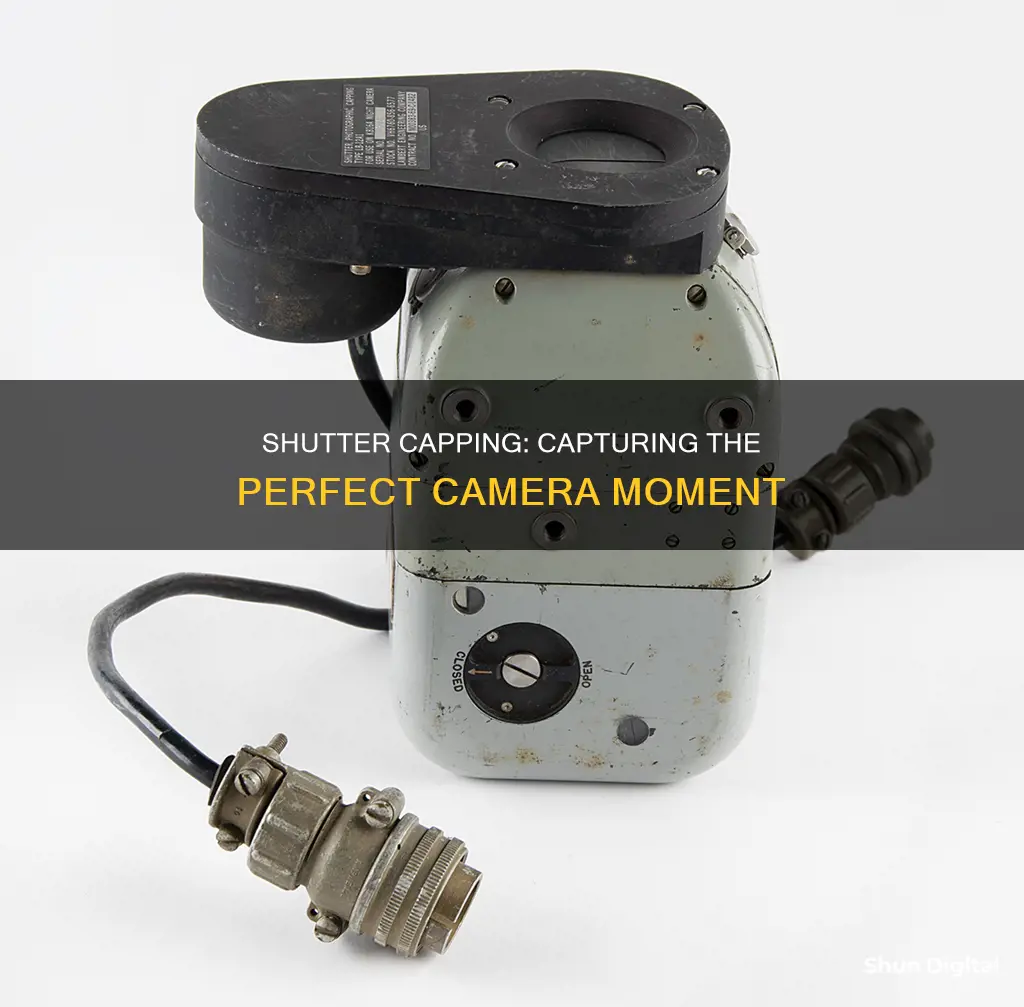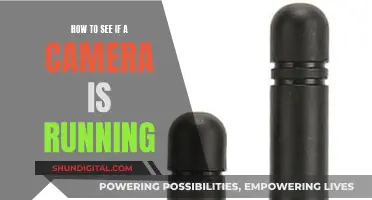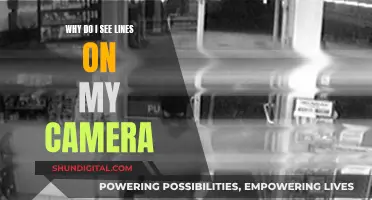
Shutter capping is a problem that occurs in cameras when the two curtains of the mechanical shutter do not move at the same speed. This results in the second curtain catching up to the first before the exposure is complete, leading to uneven images. While this can be caused by incorrect tension on the curtains or dry lubricant, it can also be due to other mechanical issues. To accurately diagnose and repair shutter capping, specialised tools and knowledge of camera repair are required.
What You'll Learn
- Shutter capping occurs when the second curtain catches up with the first
- Capping can be caused by weak tensioning, dirty or dry lubrication
- Capping can be identified by watching through the shutter as you fire at high speed
- A photoresistor can be used to measure the speed of the shutter
- A CLA is a good first step to repairing shutter capping

Shutter capping occurs when the second curtain catches up with the first
Shutter capping is a phenomenon that occurs in film cameras, particularly older models, and it can negatively impact your photographs. It happens when the second curtain, also known as the rear curtain, catches up with the first curtain (before the exposure is complete). This results in uneven exposure of the film, causing issues with the final image.
To understand shutter capping, it's important to know how a camera shutter works. The shutter consists of two curtains that open and close to control the amount of light reaching the film or sensor. When you press the shutter button, the first curtain opens, exposing the film or sensor to light, and then the second curtain closes to end the exposure. The speed at which these curtains move determines the shutter speed, which can be adjusted according to the lighting conditions and desired effect.
However, in some cases, the second curtain can lag behind or speed up, causing it to catch up with the first curtain prematurely. This results in shutter capping, where the curtains effectively "collide" before the exposure is complete, blocking light from reaching the film or sensor. This can lead to underexposure, uneven exposure, or other issues that affect the quality of the final image.
Shutter capping is often associated with timing issues, especially at slower shutter speeds. It can be caused by several factors, including lubricant issues, mechanical problems, or damage to the shutter mechanism. In some cases, it may be possible to adjust the shutter tension or clean and lubricate the mechanism to resolve the issue. However, for more complex cases, it is recommended to seek the services of a professional camera repair technician to ensure the problem is properly diagnosed and repaired.
To determine if your camera is experiencing shutter capping, it is necessary to test the camera at various shutter speeds, especially the highest ones. This can be done by taking a series of photographs at different settings and examining the results. If you notice uneven exposure or dark bands across your images, it may indicate that shutter capping is occurring. Additionally, you can use specialised tools, such as a shutter speed meter, to measure the actual shutter speed and identify any inconsistencies.
Paranoia and the Fear of Being Watched
You may want to see also

Capping can be caused by weak tensioning, dirty or dry lubrication
Shutter capping is a problem that occurs when the two curtains of a camera's shutter mechanism fall out of sync, causing the shutter to close before the entire frame has been scanned. This can result in the partial or complete absence of an image. Capping is often caused by weak tension or dirty/dry lubrication in the clockwork mechanism.
Weak tension in the shutter curtains themselves can lead to capping. Over time, the tension in the curtains can decrease, causing them to move at different speeds and fall out of sync. This can be adjusted, but it is a delicate process that requires knowledge of the camera's specific shutter timing, which can be found in the camera's service manual.
Dirty lubrication in the clockwork mechanism can also cause capping. If the lubricant is old or contaminated, it can slow down the movement of the shutter curtains, leading to capping. In some cases, excess lubricant can drip onto the curtains, affecting their movement. A good cleaning and relubrication may be necessary to resolve this issue. It is important to use the correct type of lubricant, such as watch/sewing machine oil, and to apply it properly to avoid further complications.
Dry lubrication can also be a culprit. If the lubricant dries out, it can cause friction and slow down the movement of the shutter curtains, leading to capping. In this case, re-lubrication is necessary. Again, it is important to use the correct type of lubricant and to apply it properly.
In addition to weak tension and dirty/dry lubrication, magnetic solenoid problems can also cause capping. A complete CLA (clean, lubricate, adjust) service is often recommended to address these issues and restore the camera's proper functioning.
Positioning Your Camera for the Perfect View
You may want to see also

Capping can be identified by watching through the shutter as you fire at high speed
Capping is a problem that can occur with focal plane shutters, where the two curtains do not move at the same speed. Typically, the second curtain moves faster than the first and catches up to it as they cross the film. This results in an uneven image, with correct exposure on one side of the frame, but an increasingly underexposed image on the other side.
If you are able to identify capping, the issue may be caused by weak tension, dirty or dry lubrication, or magnetic selinoid problems.
TV Cameras: Are They Watching You?
You may want to see also

A photoresistor can be used to measure the speed of the shutter
Shutter capping is a common issue in cameras, especially older ones, where the shutter speeds are not the same. This can be caused by several factors, such as dried or excess lubricant on the curtain, or other mechanical problems. To check for shutter capping, one can use a variety of tools and methods, including:
- Using a microphone and Audacity to play the shutter sound in slow motion and calculate the actual length of exposure.
- Checking the shutter speed in the EXIF data of the photo.
- Using a photoresistor to measure the light coming through the camera body when the shutter is released.
The last method, using a photoresistor, can be an effective way to measure shutter speed. Here's how it works:
A photoresistor is a light-sensitive resistor that changes its resistance based on the amount of light it receives. In this case, a photoresistor can be placed at one end of the camera, with a torch shining light through the other end. When the shutter is released, the photoresistor will detect the change in light intensity and this data can be recorded and used to calculate the shutter speed. This method is relatively simple and can be easily assembled on a breadboard with an Arduino to handle the computations.
However, it's important to note that photoresistors may not be suitable for timing events with sub-second granularity due to the time it takes for electrons in the device to adjust to changes in light exposure. Additionally, there can be a lag time of up to one second when going from lit to dark environments. For more precise measurements, a photo diode or transistor may be a better option.
Overall, while a photoresistor can be used to measure shutter speed, there are some limitations to its accuracy and speed. For more precise measurements, alternative methods or components may be considered.
Finding Your No Man's Sky Camera Photos
You may want to see also

A CLA is a good first step to repairing shutter capping
Shutter capping is a problem that can occur in cameras, particularly older models, and it can lead to issues with the shutter speeds and curtain tension. This can result in uneven exposure times and affect the overall performance of the camera.
A CLA, or Clean, Lubricate and Adjust service, is often recommended as a solution to shutter capping. This process involves cleaning and lubricating the camera's internal mechanisms, including the shutter, to ensure smooth and precise operation. By performing a CLA, you can address issues related to dried or sticky lubricants, dust, and mechanical problems that may be causing the shutter capping.
While a CLA can be a good first step, it is important to note that not all CLA services are created equal. Some may only provide superficial cleaning and lubrication, leaving more serious issues untreated. It is crucial to find a reputable technician or service provider who will thoroughly clean and adjust your camera, paying close attention to the shutter mechanism.
Additionally, a CLA may not always be sufficient to resolve shutter capping. In some cases, the issue could be related to damaged or stretched shutter curtains, which would require more extensive repairs or part replacements. It is always advisable to consult with a knowledgeable repairperson who can properly diagnose the issue and recommend the best course of action.
Furthermore, preventative maintenance is key. Regular CLA services, ideally every few years, can help keep your camera in optimal condition and reduce the likelihood of shutter capping or other issues developing over time. This is especially important for older cameras or those that have not been used for extended periods.
Apple Watch Ultra: Camera Expectations and Realities
You may want to see also
Frequently asked questions
Shutter capping is when the two curtains of a camera's mechanical shutter do not move at the same speed. Typically, the second curtain moves faster than the first and catches up to it as they cross the film, resulting in uneven exposure of the film.
You can test for shutter capping by placing a shutter tester at the left edge of the shutter curtain and taking a measurement, and then placing it at the other edge and taking another reading. If the exposure times are the same on both sides, then your camera does not have shutter capping.
Shutter capping can be caused by weak tension on the curtains, dirty or dry lubrication, or magnetic solenoid problems.
To fix shutter capping, you can try cleaning and lubricating the shutter mechanism. If that does not work, you may need to adjust the tension on the curtains or replace the shutter mechanism.







